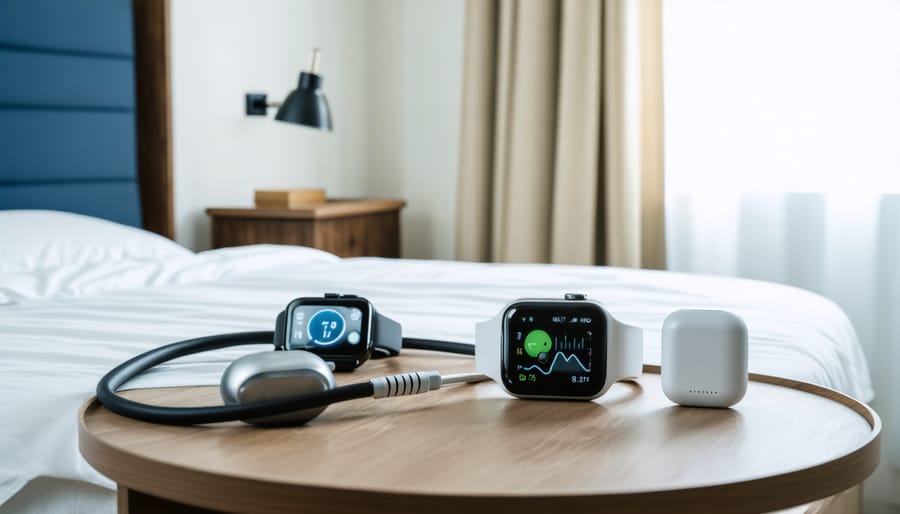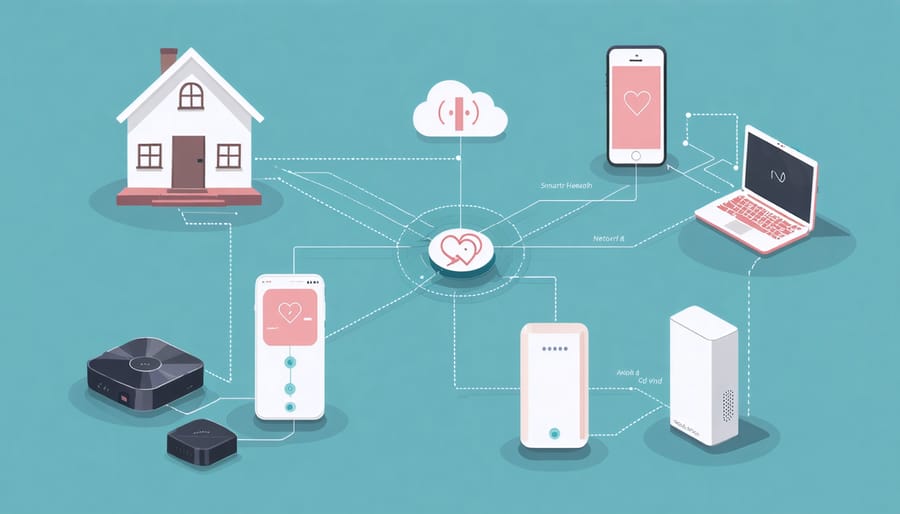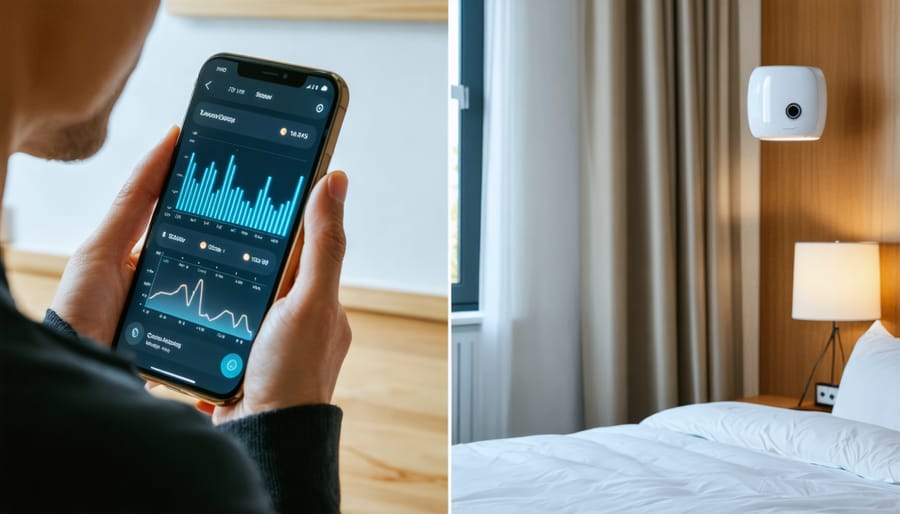Transform your home into a personal health monitoring sanctuary with today’s advanced smart home systems. From automated medication reminders to real-time vital sign monitoring, smart healthcare technology now brings hospital-grade care right into your living space.
Picture waking up to gentle health alerts, having your blood pressure automatically logged while you relax on your sofa, or receiving instant notifications when elderly family members need assistance. This isn’t science fiction – it’s the reality of modern home healthcare technology that’s transforming how we monitor and manage our wellbeing.
Smart home healthcare combines the comfort of your personal space with professional-grade medical monitoring, creating a seamless health-tracking experience that fits naturally into your daily routine. Whether you’re managing chronic conditions, caring for elderly relatives, or simply taking a proactive approach to your family’s health, these innovations offer peace of mind without sacrificing privacy or independence.
Let’s explore how you can create a home environment that actively supports your health while maintaining the warmth and comfort you cherish.
Essential Components of a Health-Focused Smart Home
Health Monitoring Devices
Today’s health monitoring devices bring the power of a medical clinic right into your home, making it easier than ever to keep track of your family’s well-being. Smart blood pressure monitors can now automatically record your readings, track trends over time, and even share data directly with your healthcare provider. These devices often come with user-friendly apps that help you understand your numbers and alert you to any concerning patterns.
Sleep trackers have evolved beyond simple movement sensors to comprehensive health tools. Modern versions monitor your heart rate, breathing patterns, and sleep stages, providing detailed insights into your rest quality. Many can even detect potential sleep disorders and offer personalized recommendations for better sleep hygiene.
Activity sensors and smart watches have become increasingly sophisticated, tracking everything from step counts to heart rhythm irregularities. These devices can monitor your daily activity levels, exercise intensity, and even detect falls – particularly valuable for seniors aging in place. Some advanced models now include features like blood oxygen monitoring and stress level tracking through heart rate variability.
Smart scales do more than just measure weight; they can track body composition, including muscle mass and bone density, creating a more complete picture of your health journey. Many of these devices can recognize multiple users, making them perfect for family health monitoring.
Remember to look for devices that integrate well with your existing smart home setup and offer secure data protection for your health information.

Environmental Quality Monitors
Environmental quality plays a crucial role in our health and well-being, which is why modern smart homes are incorporating sophisticated smart monitoring sensors to track indoor conditions. These devices work together to create a healthier living environment by constantly measuring and adjusting various environmental factors.
Air quality sensors are particularly important, as they detect harmful pollutants, volatile organic compounds (VOCs), and particulate matter that could affect respiratory health. These sensors can trigger air purifiers or ventilation systems when air quality drops below optimal levels, ensuring you’re always breathing clean air.
Humidity monitors help maintain the perfect moisture balance in your home. Too much humidity can promote mold growth and dust mite proliferation, while too little can cause dry skin and respiratory discomfort. Smart humidity sensors work with humidifiers and dehumidifiers to keep levels in the ideal 30-50% range.
Temperature control systems have evolved beyond simple thermostats. Modern systems can create different temperature zones throughout your home, automatically adjust based on time of day or occupancy, and even learn your preferences over time. They can also help prevent temperature-related health issues, especially for elderly residents or those with chronic conditions.
These environmental monitors can be controlled through smartphone apps, allowing you to check conditions and make adjustments even when you’re away from home. Many systems also provide historical data and alerts, helping you maintain optimal conditions for your family’s health.
Setting Up Your Health-Smart Home
Planning Your System
Creating a smart home healthcare system starts with a thoughtful assessment of your needs and goals. Begin by listing specific health concerns you’d like to monitor and daily activities that could benefit from automation. Whether you’re looking to transform your living space for aging parents or managing your own health conditions, having clear objectives will guide your device selection.
Next, evaluate your existing home setup and WiFi capabilities. Most smart healthcare devices require reliable internet connectivity, so ensure your network can handle additional devices. Consider creating a dedicated network for your healthcare devices to maintain privacy and prevent interference.
When selecting devices, focus on compatibility. Look for products that work with your existing smart home ecosystem (like Google Home, Apple HomeKit, or Amazon Alexa). Create a list of must-have features versus nice-to-have additions to stay within budget while meeting essential needs.
Important considerations include:
– Device accuracy and reliability ratings
– Data privacy features and encryption
– Ease of use for all household members
– Integration capabilities with other health apps
– Battery life and maintenance requirements
– Emergency alert systems and backup power options
Start small with core devices and expand gradually. This approach allows you to learn each system thoroughly and ensure it meets your needs before adding more components. Remember to involve family members or caregivers in the planning process, as their input and comfort with the technology will be crucial for successful implementation.

Integration and Connectivity
Creating a unified smart home healthcare system starts with choosing a central hub that can communicate with all your devices. Popular options like Samsung SmartThings, Apple HomeKit, or Google Home serve as excellent foundations for your connected health monitoring setup.
The key to successful integration is ensuring device compatibility. Before purchasing any health monitoring equipment, check that it works with your chosen hub system. Look for devices that support common protocols like WiFi, Zigbee, or Z-Wave, as these offer the most reliable connections and widest compatibility.
To build your system, start with these simple steps:
1. Set up your main hub and connect it to your home’s WiFi network
2. Install the hub’s smartphone app, which will serve as your control center
3. Add devices one at a time, following the manufacturer’s pairing instructions
4. Create automation routines that link different devices together
For example, you might connect your smart blood pressure monitor to automatically log readings in your health app while triggering your smart lights to change color if readings are outside normal ranges. You can also set up medication reminders that activate connected pill dispensers and send notifications to your phone.
Consider creating zones in your home where different health monitoring devices work together. Your bedroom might include sleep tracking devices, air quality monitors, and smart lighting that adjusts based on your sleep patterns. Meanwhile, your bathroom could feature connected weight scales and medication reminders.
Remember to regularly update all device firmware and check connection status to ensure your system runs smoothly. It’s also wise to set up backup power solutions for critical health monitoring devices to maintain continuous operation during power outages.
Daily Benefits and Lifestyle Improvements
Preventive Health Monitoring
Smart homes are becoming increasingly adept at monitoring our health, acting as vigilant guardians that can spot potential issues before they become serious problems. These systems use a network of sensors and smart devices to track vital signs and daily patterns, offering peace of mind for both residents and their loved ones.
Motion sensors can detect changes in walking patterns or unusual periods of inactivity, which might indicate mobility issues or falls. Smart mattresses and bedding monitor sleep quality, heart rate, and breathing patterns while you rest, providing valuable insights into your nighttime health. Even smart toilets can analyze waste products for early signs of health concerns.
Environmental monitoring plays a crucial role too. Air quality sensors measure pollutants and allergens, while humidity monitors help prevent conditions that could trigger respiratory issues. Smart lighting systems adjust automatically to support your natural circadian rhythm, promoting better sleep and overall well-being.
Many of these systems connect to smartphone apps that track trends over time and can alert both residents and caregivers when patterns change significantly. For example, if someone’s daily activity level suddenly drops or their sleep becomes severely disrupted, the system can send notifications to designated family members or healthcare providers.
The beauty of preventive health monitoring lies in its passive nature – you don’t need to remember to check anything or manually record data. The system works quietly in the background, collecting and analyzing information to help you stay ahead of potential health concerns.

Wellness Optimization
Smart home technology is revolutionizing how we approach our daily wellness routines, making it easier than ever to maintain healthy habits. Connected devices work together to create an environment that naturally promotes better lifestyle choices throughout your day.
Smart lighting systems can gradually brighten your bedroom in the morning, mimicking natural sunlight to help regulate your sleep-wake cycle. Connected sleep monitors track your rest patterns and automatically adjust your room’s temperature and humidity for optimal sleeping conditions.
Smart water bottles and kitchen devices remind you to stay hydrated and eat at regular intervals, while connected fitness equipment provides real-time feedback on your workout form and progress. Voice-activated assistants can guide you through meditation sessions or gentle stretching routines, making wellness activities more accessible and enjoyable.
Environmental sensors continuously monitor air quality, alerting you when it’s time to ventilate or when allergen levels are high. Smart blinds can automatically adjust to maximize natural light exposure, which helps maintain healthy circadian rhythms and boost mood.
The beauty of these systems lies in their ability to learn your patterns and preferences over time. They can suggest adjustments to your daily routine based on your health goals and actual behavior, making wellness optimization feel less like a chore and more like a natural part of your lifestyle. The data collected can also provide valuable insights into your health trends, helping you make more informed decisions about your well-being.
Privacy and Security Considerations
When bringing healthcare technology into your smart home, protecting your sensitive medical data should be a top priority. Just as you take steps to protect your connected home, your health information needs robust safeguards.
Start by choosing devices from reputable manufacturers that prioritize data encryption and regular security updates. Look for products that comply with HIPAA guidelines and other healthcare privacy standards. When setting up your devices, always change default passwords to strong, unique combinations and enable two-factor authentication wherever possible.
Create a separate Wi-Fi network specifically for your healthcare devices to isolate them from other smart home products and potential security risks. Regular network security audits and firmware updates help maintain a protective barrier around your sensitive information.
Be mindful of who has access to your health data. Set up individual user accounts for family members and caregivers, and regularly review access permissions. Consider using a password manager to keep track of different login credentials securely.
Data storage is another crucial consideration. If your devices store health information in the cloud, verify that the service provider uses end-to-end encryption and has clear privacy policies. For local storage, ensure your home network has robust firewall protection and regular backup procedures.
Stay informed about privacy settings on your healthcare apps and devices. Many offer granular control over what data is collected and shared. Take time to understand these options and adjust them according to your comfort level. Remember that convenience should never compromise the security of your personal health information.
When disposing of old devices, properly wipe all stored data and reset them to factory settings. This prevents unauthorized access to your health history if the devices are recycled or fall into the wrong hands.
As we look to the future of home healthcare, smart monitoring systems are revolutionizing how we manage our well-being. These innovative solutions offer peace of mind through continuous health tracking, early detection of potential issues, and improved independence for elderly or vulnerable family members.
The benefits of smart home healthcare extend beyond basic monitoring. From automated medication reminders to fall detection systems and vital sign tracking, these technologies create a comprehensive safety net that supports both preventive care and emergency response. For families caring for elderly relatives or those managing chronic conditions, these systems provide invaluable support and reassurance.
Looking ahead, we can expect even more sophisticated integration of healthcare technologies in our homes. Artificial intelligence and machine learning will continue to improve the accuracy of health predictions and personalized care recommendations. We’ll likely see enhanced telemedicine capabilities, allowing for more seamless communication between patients and healthcare providers directly through smart home systems.
As these technologies become more affordable and user-friendly, they’ll become increasingly accessible to more households. Whether you’re just starting to explore smart home healthcare or looking to expand your existing setup, the investment in these systems can significantly improve quality of life and healthcare outcomes for you and your loved ones.
Remember, the goal is to create a supportive, health-conscious living environment that works seamlessly with your lifestyle while providing the security and care monitoring you need.
